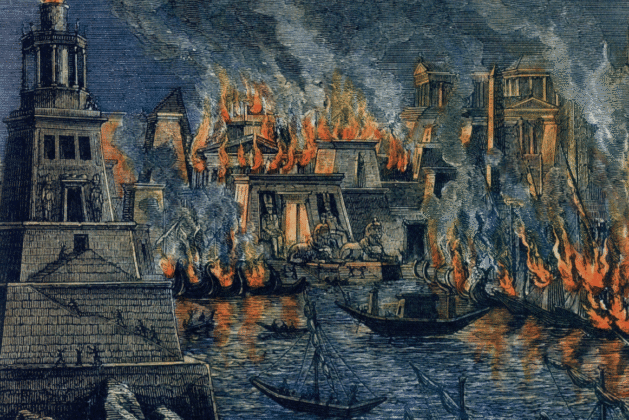Long before Oxford, Harvard, or Nalanda ever existed, there stood a remarkable institution in ancient Egypt that brought together scholars, scientists, poets, and philosophers from around the world. Known as the Museum of Alexandria, this extraordinary center of learning was more than just a building—it was a powerful symbol of intellectual ambition. But was it truly the world’s first university? Let’s dive into history to explore what made the Museum of Alexandria so revolutionary, and why its legacy still shapes the world of education today.
Table of Contents
Introduction: Where Knowledge Was Worshipped
In the vibrant city of Alexandria, founded by Alexander the Great around 331 BCE, stood one of humanity’s greatest intellectual achievements—the Mouseion (Greek for “Institution of the Muses”). Often overshadowed by the more famous Library of Alexandria, the Museum was its academic heart and soul. A research hub, educational academy, and intellectual sanctuary all in one, this ancient institution was designed to gather the best minds from across cultures to study, share, and preserve knowledge.
In many ways, the Museum of Alexandria functioned like a modern university—with resident scholars, lectures, debates, laboratories, and government support. It was a beacon of enlightenment in an ancient world.
What Was the Museum of Alexandria?
The Mouseion was not a museum in today’s sense of the word. It was a state-funded institute dedicated to the nine Muses—the goddesses of the arts and sciences. It featured:
- Lecture halls
- Meeting rooms for scholars
- Living quarters for researchers
- Gardens and courtyards for philosophical debates
- Research spaces, laboratories, and observatories
More importantly, it was directly connected to the Great Library of Alexandria, making it a complete intellectual ecosystem. Think of it as a mix between a modern-day university, think tank, and research institute.
A Global Community of Scholars
Under the patronage of the Ptolemaic dynasty, particularly Ptolemy I and Ptolemy II, the Museum attracted scholars from across Greece, Egypt, Mesopotamia, India, and even Africa.
Some of the most famous minds associated with the Museum include:
- Eratosthenes – Calculated the Earth’s circumference with remarkable accuracy
- Euclid – The “father of geometry,” whose mathematical texts are still studied
- Herophilos – Conducted human dissections and advanced the study of anatomy
- Archimedes – Developed mathematical principles and mechanical innovations
- Callimachus – Created the first library catalog system
This global mix made the Museum a melting pot of ideas, a place where cultures converged through curiosity.
What Did They Study?
The scope of study was vast and incredibly diverse. Scholars in the Museum worked on:
- Mathematics and geometry
- Medicine and anatomy
- Astronomy and geography
- Linguistics and philology
- Philosophy and logic
- Engineering and mechanics
- Literature, poetry, and history
They compiled texts, wrote commentaries, translated works from multiple languages, and preserved much of the world’s classical knowledge—until its tragic loss.
University Before Universities?
Let’s break down why the Museum of Alexandria might qualify as the first university in human history:
| Feature | Modern Universities | Museum of Alexandria |
|---|---|---|
| Central campus | ✅ | ✅ |
| Resident scholars | ✅ | ✅ |
| Government funding | ✅ | ✅ |
| Multidisciplinary study | ✅ | ✅ |
| Libraries and research | ✅ | ✅ |
| Curriculum and teaching | ✅ | ✅ |
| Scholarly collaboration | ✅ | ✅ |
The major difference is that the Museum may not have awarded degrees. But by nearly every other definition—teaching, research, intellectual community, and institutional support—it laid the blueprint for future academic institutions.
What Happened to It?
Sadly, like the Library it was connected to, the Museum of Alexandria eventually fell victim to war, fire, and neglect. Scholars disagree on the exact timeline, but its decline likely occurred during the Roman conquest and civil wars. The spirit of the institution, however, lived on in centers of learning that emerged later, such as:
- The House of Wisdom in Baghdad
- Al-Azhar University in Cairo
- The universities of Bologna, Oxford, and Paris
Each owed some debt to the intellectual model first seen in Alexandria.
Why It Still Matters Today
In an age of misinformation and information overload, the story of the Museum of Alexandria is more relevant than ever. It reminds us of the value of:
- Preserving knowledge
- Encouraging global collaboration
- Respecting scientific inquiry
- Creating spaces for free thought
Imagine what humanity could have achieved had the Museum survived another few centuries. Perhaps we’d have discovered electricity, space travel, or germ theory hundreds of years earlier.
Conclusion: A Vision Worth Reviving
The Museum of Alexandria was not just a building—it was a vision. A vision of a world where knowledge was shared freely, where scholars could question and explore without fear, and where curiosity was a virtue. While we may never recover the thousands of scrolls lost to history, we can revive the spirit of the Museum by promoting education, intellectual freedom, and a deep respect for learning.
Was it the world’s first university? Maybe not in the official sense. But in purpose, in practice, and in legacy—it very well might have been.
Read More: Ancient Egyptian Medicine: A Legacy of Science and Spiritual Healing




